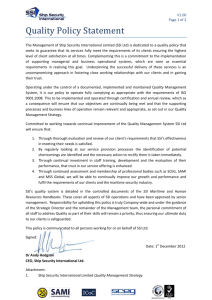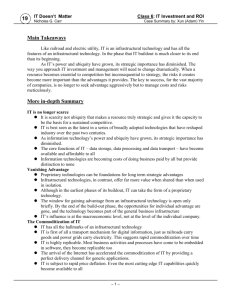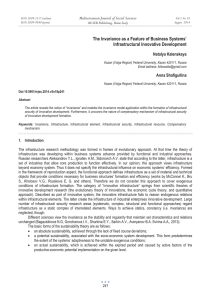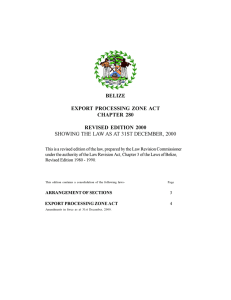STATE INDUSTRIAL POLICIES
advertisement
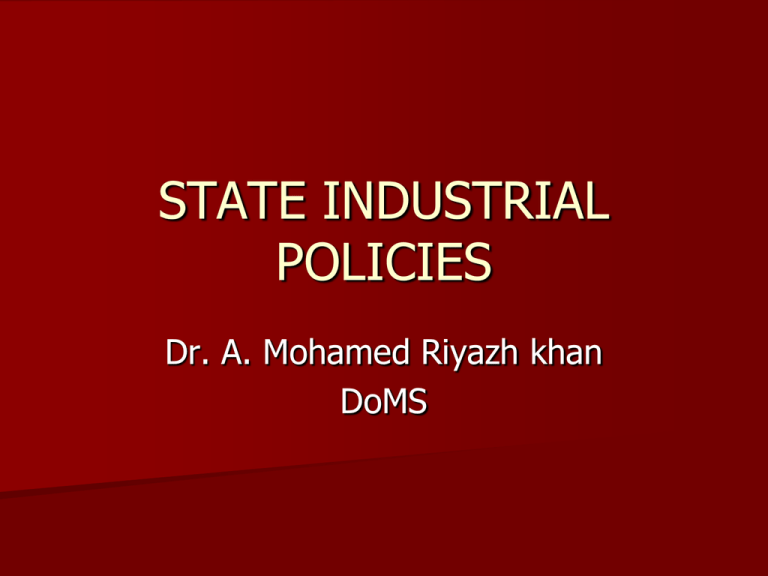
STATE INDUSTRIAL POLICIES Dr. A. Mohamed Riyazh khan DoMS STATE INDUSTRIAL POLICIES State / UT Govts. – Pursue central Govt. industrial policies and get assistance under different centrally sponsored schemes. The central policy framework – guiding principle for states Technical and other support services – through DIC,s Main Areas of Support To develop and manage industrial areas of respective Industrial development and investment corporations Financial Support services by SFC’s Technical Support services by TCO’s Human Resource development by a host of Training Institutions Infrastructure Development by small Industry and Export corporation Single window assistance by DIC’s Other Incentives Providing land and developed plots/ sheds on concessional terms Industrial infrastructural facilities Subsidy on investment (in selected areas) Sales tax and stamp duty exemptions Water supply at reduced rates Seed capital assistance for setting up units The Policy of Protection / Reservation To make SSI economically viable Upward revision and expansion of definition of SSI’s Identification and Reservation of products for exclusive production Identification and Reservation of products for exclusive Purchase of Government (remaining products provided price preference) Trade policy restrictions on Import’s – through Licensing system Economic Reforms and SSI policy A relatively open trade / exchange rate policy Removal of controls on Foreign Investment flows Financial sector reform – Deregulation & De-licensing of industrial and infrastructural sectors Tax reforms FDI’s in Small Scale Sectors Since 1991 – equity participation – upto 24% of total shareholding If proposal to export 50% of production of items reserved – higher equity participation Non-SSI unit may also manufacture reserved items if export is upto 50% and above Infrastructural Facilities Industrial Estate Programmes Started in 1955 to encourage entrepreneurs to set up small industries and to expand units Facilities 1. Acquisition of suitable land and its development 2. Subsidy on rent for factory accommodation 3. Construction of factory shed – allotment of sheds through sale / Hire-purchase 4. Provision of infrastructure – water, electricity, banks, canteens, transport etc., 5. Exemption from sales tax 6. Concessional charges for water and power supply Main Objectives of Industrial Estate Facilitate growth of SSI’s Shift industries from congested areas to estate premises Achieve decentralized development in small towns and villages Develop sub-contracting relationship with large industries Establish common facility services centers etc., Implementation – through state / UT Govts. After 1979 – transferred programmes to State Industrial Development Corporation Development of EPZ / Industrial Parks EPZ – Special incentive to undertake manufacturing of export items from India Fall under Ministry of Commerce Special areas designated for export production or processing of manufactured products at a low cost Basic infrastructural facilities are provided at reduced rates – developed land sites, standard designated factory buildings, roads, power, water, drainage, banking, post-offices and custom clearing agents Development of EPZ / Industrial Parks EOU’s are permitted to sell upto 25% of value of production in Domestic Traffic Area 7 EPZ’s established across the country Kandla Free Trade Zone (1965) SantaCurz Electronic EPZ (1974) Falta EPZ (1984) Chennai, Kochi, Visakapattinam, Noida Industrial / Technical Parks In 1984 – India Govt. formulated policy for computer Hardware development – Electronics Hardware technology parks In 1986 – Computer software development – STP’s Bio-tech parks, Leather Park etc., Private- public parternerships- Eg. IT park in Bangalore by Tata Groups, Singapore and Karnataka Govts. Integrated Infrastructural Development Scheme (IID) Announced in March 7,1991 Till 1998 – 40 IID’s centers have been sanctioned Objectives To establish 60 IID centers in rural / backward districts To promote SSI and tiny unit clusters – employment and exports To promote stronger linkages between agriculture and industry To provide common facilities and technological back up services To create infrastructural facilities Integrated Infrastructural Development Scheme (IID) Size of center - 15 to 20 hectares – 450 SSI inits Financing upto 50 million Central Govt. – 20 million Loan component – 30 million State / UT Govts. Will meet cost in excess 50 million Upgrading facilities – 40 % Govt. grant & 60 % SIDBI loan Small Industry Clusters Defined as “a sectoral and geographical concentration of enterprises” “A local agglomeration of enterprises which produces and sells a range of related and complementary products and services” Ex: Sports Goods (Meerut) Glass Products (Firozabad) Foundries (Agra) Easy availability of Raw materials, trained artisans / proximity to market Benefits of Clusters to SSI’s Unique state of togetherness Backward and Forward economic linkages Business and social integration Economies of agglomeration – network of suppliers Specialization in the manufacturing process Inter-firm relationships in production activities Sharing of information and experiences Develops network of subcontracting between firms Classification of Clusters Natural Clusters – Emerge for products produced in a traditional manner and have no exposure to technology changes, design and manufacturing processes Induced Clusters – Set up by Govt. or other agencies through creation of infrastructure which is accompanied by a range of technical services Cluster Development Programmes 1. Product cum Process Development Centers(PPDC’s) – Established by SIDo – technical support services Functions – R&D, product design and innovation, product and process improvements, improved packaging techniques, etc., Ex: Ceramic and Glass – Ranchi Household electrical – Mumbai Electronic – Ramnagar, UP Oil & Perfume – Kannanj, UP Cluster Development Programmes 2. Central Footwear Training Centers (CFTC’s) – Training for new types of footwear to increase exports – at Calcutta, Mumbai, Agra, Chennai 3. Integrated Technology Upgration & Modernization Programms (UPTECH) – In 9th five year plan – project cost – Rs. 62.5 million for entire plan period Cluster Development Programmes This programme includes i. Studies on technical status and needs of identified clusters in traditional skill based enterprises ii. Identification of appropriate technologies and suppliers iii. Facilitation of contract / need based research for adoption of available technology iv. Promotion of technologies among target groups of SSI’s through demonstrations Implemented in following centers Pottery cluster at Khurja (UP) Food Processing at Pune (Maharastra) Forging Industries at Ludhiana Auto components at Chennai, Indore Toy industries at Delhi & Noida (UP) Hosiery at Kanpur (UP)






